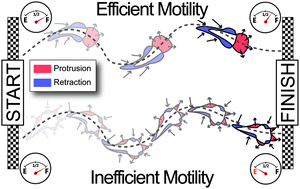Motility efficiency and spatiotemporal synchronization in non-metastatic vs. metastatic breast cancer cells†
Abstract
Metastatic breast cancer cells move not only more rapidly and persistently than their non-metastatic variants but in doing so use the mechanical work of the cytoskeleton more efficiently. The efficiency of the cell motions is defined for entire cells (rather than parts of the cell membrane) and is related to the work expended in forming membrane protrusions and retractions. This work, in turn, is estimated by integrating the protruded and retracted areas along the entire cell perimeter and is standardized with respect to the net translocation of the cell. A combination of cross-correlation, Granger causality, and morphodynamic profiling analyses is then used to relate the efficiency to the cell membrane dynamics. In metastatic cells, the protrusions and retractions are highly “synchronized” both in space and in time and these cells move efficiently. In contrast, protrusions and retractions formed by non-metastatic cells are not “synchronized” corresponding to low motility efficiencies. Our work provides a link between the kinematics of cell motions and their energetics. It also suggests that spatiotemporal synchronization might be one of the hallmarks of invasiveness of cancerous cells.


 Please wait while we load your content...
Please wait while we load your content...